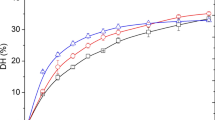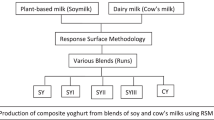Abstract
Cow’s milk proteins belong to food allergens. The composition of milk is influenced by many factors, among others by cows’ feeding. Thus, the aim of the study was to check if introducing legumes seeds (soy meal and ground lupine) into fodder changes the composition of milk immunoreactive protein. 18 milk samples were compared, (UHT milks and samples obtained from local farms). The differences in the total protein content were not statistically significantly different, but the studied milk varied in the content of histidine, serine, aspartic acid, glutamic acid, lysine, phenylalanine, and tyrosine. To control immunoreactivity of milk proteins, extracts in PBS were prepared. Thus, the samples were deprived of most of casein—the main milk allergen. Immunoreactivity of the milk from the local farms and obtained from the cows fed with a fodder containing soy (FS) differed from the immunoreactivity of UHT milk and the milk from the cows fed with a fodder containing soy and lupine (FL) and without the addition of legumes (NL). It was proved by a slot-blot analysis, both with sera of the children allergic solely to milk, as well the children allergic solely to soy (not to milk). SDS-PAGE analysis of the prepared extracts showed the presence of additional peptide bands: ~ 18 kDa in case of the most of immunoreactive milks (FS).





Similar content being viewed by others
References
FAO (2013) Food and Agriculture Organization of The United Nations. Milk and dairy products in human nutrition. Rome, Italy. http://www.fao.org/3/i3396e/i3396e.pdf Accessed 19 July 2019
Liu AH, Jaramillo R, Sicherer SH, Wood RA, Bock A, Bock A, Burks W, Massing M, Cohn RD, Zeldin DC (2010) National prevalence and risk factors for food allergy and relationship to asthma: results from the national health and nutrition examination survey 2005–2006. J Allergy Clin Immunol 126:798–806. https://doi.org/10.1016/j.jaci.2010.07.026
Lifschitz C, Szajewska H (2015) Cow’s milk allergy: evidence-based diagnosis and management for the practitioner. Eur J Pediatr 172:141–150. https://doi.org/10.1007/s00431-014-2422-3
Navarrete-Rodriguez EM, Rios-Villalobos LA, Alcocer-Arreguin CR, Del-Rio-Navarro BE, Del-Rio-Chivardi JM, Saucedo-Ramirez OJ, Sienra-Monge JJL, Frias RV (2018) Cross-over clinical trial for evaluating the safety of camel’s milk intake on patients who are allergic to cow’s milk protein. Allergol Immunopathol (Madr) 46:149–154. https://doi.org/10.1016/j.aller.2017.06.005
Rozenfeld GH, Docena MC, Anon MC, Fossati CA (2002) Detection and identification of a soy protein component that cross-reacts with caseins from cow’s milk. Clin Exp Immunol 130:49–58. https://doi.org/10.1046/j.1365-2249.2002.t01-1-01935.x
Vandenplas Y, De Greef E, Devreker T (2014) Treatment of cow’s milk protein allergy. J Pediatr Gastroenterol Nutr 1:1–5. https://doi.org/10.5223/pghn.2014.17.1.1
Docena G, Fernandez R, Chirdo F, Fossati C (1996) Identification of casein as the major allergenic and antigenic protein of cow’s milk. Allergy 51:412–416. https://doi.org/10.1111/j.1398-9995.1996.tb04639.x
Bellioni-Businco B, Paganelli R, Lucenti P, Giampietro PG, Perborn H, Businco L (1999) Allergenicity of goat’s milk in children with cow’s milk allergy. J Allergy Clin Immunol 6:1191–1194. https://doi.org/10.1016/S0091-6749(99)70198-3
Natale M, Bisson C, Monti G, Peltran A, Garoffo LP, Valentini S, Fabris C, Bertino E, Coscia A, Conti A (2004) Cow’s milk allergens identification by two-dimensional immunoblotting and mass spectrometry. Mol Nutr Food Res 48:363–369. https://doi.org/10.1002/mnfr.200400011
Lewis M, Heppell N (2000) Effects on Milk Food Components. In: Litzenberg K (ed) Continuous thermal processing of foods: pasteurization and UHT sterilization. Aspen Publishers Inc., Gaithersburg
Jovanovic S, Barac M, Macej O, Vucic T, Lanjevac C (2007) SDS-PAGE analysis of soluble proteins in reconstituted milk exposed to different heat treatments. Sensors 7:371–383. https://doi.org/10.3390/s7030371
Kattan JD, Cocco RR, Javinen KM (2011) Milk and soy allergy. Pediatr Clin North Am 58:407–426. https://doi.org/10.1016/j.pcl.2011.02.005
Baumgartner S, Schubert-Ullrich P (2010) Soy (Glycine max) allergens. In: Jedrychowski L, Wichers HJ (eds) Chemical and biological properties of food allergens, 1st edn. CRC Press, Taylor and Francis Group, Boca Raton. https://doi.org/10.1201/9781420058574
Curciarello R, Smaldini PL, Candreva AM, Gonzalez V, Parisi G, Cauerhff A, Barrios I, Blanch LB, Fossati CA, Petruccelli S, Docena GH (2014) Targeting a cross-reactive Gly m 5 soy peptide as responsible for hypersensitivity reactions in a milk allergy mouse model. PLoS One 9(1):e82341. https://doi.org/10.1371/journal.pone.0082341
Tyasi TL, Gxasheka M, Tlabela CP (2015) Assessing the effect of nutrition on milk composition of dairy cows: a review. Int J Curr Sci 17:56–63
Peeters KA, Nordlee JA, Penninks AH, Chen L, Goodman RE, Bruijnzeel-Koomen M, Hefle SL, Taylor S, Knulst AC (2007) Lupine allergy: not simply cross-reactivity with peanut or soy. J Allergy Clin Immunol 3:647–653. https://doi.org/10.1016/j.jaci.2007.05.032
ISO 1871:2009 (2009) Food and feed products—general guidelines for the determination of nitrogen by the Kjeldahl method. ISO, Geneva
Bradford MM (1976) A rapid and sensitive method for the quantitation of microgram quantities of protein utilizing the principle of protein-dye binding. Anal Biochem 72(1–2):248–254. https://doi.org/10.1006/abio.1976.9999
Tomczak A, Zielińska-Dawidziak M, Piasecka-Kwiatkowska D, Lampart-Szczapa E (2018) Blue lupine seeds protein content and amino acids composition. Plant Soil Environ 64:147–155. https://doi.org/10.17221/690/2017-PSE
Laemmli UK (1970) Cleavage of structural proteins during the assembly of the head of bacteriophage T4. Nature 227:680–685. https://doi.org/10.1038/227680a0
Maciński J, Kowalski IM, Zwierzchowski G, Szarek J, Pierożyński B, Zabłocka E (2013) Characteristics of cow’s milk protein including allergenic properties and methods for its reduction. Pol Ann Med 20:69–76. https://doi.org/10.1016/j.poamed.2013.07.006
Wang L, Wang Q, Liang Q, He Y, Wang Z, He S, Xu J, Ma H (2015) Determination of bioavailability and identification of collagen peptide in blood after oral ingestion of gelatin. J Sci Food Agric 95:2712–2717. https://doi.org/10.1002/jsfa.7008
Casas R, Böttcher MF, Duchén K, Björkstén B (2000) Detection of IgA antibodies to cat, β-lactoglobulin, and ovalbumin allergens in human milk. J Allergy Clin Immunol 105:1236–1240. https://doi.org/10.1067/mai.2000.105805
Xu Q, Liu Z, Liu H, Zhao F, Huang X, Wu Y, Liu J (2018) Functional characterization of oligopeptide transporter 1 of dairy cows. J Anim Sci Biotechnol. https://doi.org/10.1186/s40104-017-0219-8
Cichocki T, Litwin J, Mirecka J (2016) Kompendium histologii (Histology compendium), 5th edn. Wydawnictwo Uniwersytetu Jagielońskiego, Kraków (in Polish)
Mills C, Moreno FJ, Sancho AI, Jenkins JA, Wichers HJ (2004) Processing approaches to reducing allergenicity in proteins. In: Yada RY (ed) Proteins and food processing. Woodhead Publishing Limited, Cambridge
Wuthrich B, Johansson SGO (1995) Allergy to cheese produced from sheep’s and goat’s milk but not cheese produced from cow’s milk. J Allergy Clin Immunol 96:270–273. https://doi.org/10.1016/s0091-6749(95)70021-8
Calvani M, Alessandri C (1998) Anaphylaxis to sheep’s milk cheese in a child unaffected by cow’s milk protein allergy. Eur J Pediatr 157:17–19. https://doi.org/10.1007/s004310050759
Islam MA, Ekeberg D, Rukke EO, Vegrud GE (2015) Ex vivo digestion of milk from red Chittagong cattle focusing proteolysis and lipolysis. Asian Australas J Anim Sci 28:559–567. https://doi.org/10.5713/ajas.14.0269
Acknowledgements
The authors specially thank SNOZ Allergology Plus Center for Diagnosis and Treatment of Allergy Therapy in Poznan (Poland) for providing sera. The work was financially supported by the Polish Ministry of Science and Higher Education.
Author information
Authors and Affiliations
Corresponding author
Ethics declarations
Conflict of interest
The authors declare that they have no conflict of interest in publishing this research.
Compliance with Ethics Requirements
Ethical approval for the use of human sera was obtained from the local ethics committee (No. 671/17, 2017).
Additional information
Publisher's Note
Springer Nature remains neutral with regard to jurisdictional claims in published maps and institutional affiliations.
Rights and permissions
About this article
Cite this article
Tomczak, A., Zielińska-Dawidziak, M. & Piasecka-Kwiatkowska, D. Differences in the immunoreactivity of milk from local farms and from points of purchase. Eur Food Res Technol 246, 93–101 (2020). https://doi.org/10.1007/s00217-019-03400-2
Received:
Accepted:
Published:
Issue Date:
DOI: https://doi.org/10.1007/s00217-019-03400-2




